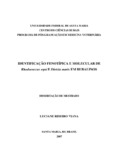| dc.creator | Viana, Luciane Ribeiro | |
| dc.date.accessioned | 2017-06-14 | |
| dc.date.available | 2017-06-14 | |
| dc.date.issued | 2007-08-28 | |
| dc.identifier.citation | VIANA, Luciane Ribeiro. Phenotypical and molecular identification of Rhodococcus equi and Dietzia maris in buffaloes. 2007. 68 f. Dissertação (Mestrado em Medicina Veterinária) - Universidade Federal de Santa Maria, Santa Maria, 2007. | por |
| dc.identifier.uri | http://repositorio.ufsm.br/handle/1/9994 | |
| dc.description.abstract | The bacterial identification in laboratories of microbiology is achieved by using several morphophysiological and genetic factors. Some members of the actinomycetes group, like the genera Rhodococcus, Gordonia, Nocardia and Dietzia have similar phenotypical characteristics. As result of this, the laboratorial detection of these microorganisms is often faced with bacterial identification problems. The present work analyzed 24 bacterial isolates from milk and skin of buffalo females (Bubalus bubalis), which previously had been identified as Rhodococcus equi, by using a restricted number of phenotypical tests for bacterial characterization. Using additional biochemical tests and molecular tools, the goal of this study was to perform the characterization of these isolates, as well as the differentiation of other microorganisms closely related. The results of the phenotypical tests had not allowed distinguishing definitely the isolates, once that they demonstrated relationship with two correlated genera, Rhodococcus and Dietzia. Despite the fact, these results allowed the separation of the isolates in three distinct biotypes. Only one of the isolates was confirmed as R. equi through the PCR multiplex specifically for this specie, as well DNA sequencing and DNA fragment analysis. All the other isolates only could be precisely identified after the DNA sequencing, where they were characterized as Dietzia maris. The sensitivity profile to antimicrobials demonstrated the biggest resistance of the D. maris isolates to oxacillin and rifampin, 96% and 87% respectively. The R. equi isolate, presented resistance to amikacin, oxacillin, penicillin, rifampin and tetracycline. Alert for the risk of the incorrect identification of the bacterial isolates by using diagnostic analysis based on phenotypical tests in order to differentiate R. equi and D. maris, besides the necessity to use of complementary tests for differentiation of these microorganisms. | eng |
| dc.format | application/pdf | por |
| dc.language | por | por |
| dc.publisher | Universidade Federal de Santa Maria | por |
| dc.rights | Acesso Aberto | por |
| dc.subject | Rhodococcus sp. | por |
| dc.subject | Dietzia sp. | por |
| dc.subject | Fenotipia | por |
| dc.subject | Seqüenciamento de DNA | por |
| dc.subject | Phenotypic test | eng |
| dc.subject | DNA sequencing | eng |
| dc.title | Identificação fenotípica e molecular de Rhodococcus equi e Dietzia maris em bubalinos | por |
| dc.title.alternative | Phenotypical and molecular identification of Rhodococcus equi and Dietzia maris in buffaloes | eng |
| dc.type | Dissertação | por |
| dc.description.resumo | A identificação bacteriana em laboratórios de microbiologia é realizada pela observação de um conjunto de fatores morfofisiológicos e genéticos. Alguns membros do grupo dos actinomicetos, como os gêneros Rhodococcus, Gordonia, Nocardia e Dietzia possuem características fenotípicas semelhantes. Por conseqüência, a identificação microbiológica destes agentes pode enfrentar algumas dificuldades. Neste trabalho foram analisados 24 isolados bacterianos oriundos de leite e pele de búfalas (Bubalus bubalis), os quais foram previamente identificados como Rhodococcus equi, com o uso de um número restrito de testes fenotípicos considerados discriminatórios para a caracterização bacteriana. Com o auxílio de testes bioquímicos adicionais e de ferramentas moleculares objetivou-se neste estudo, realizar a caracterização desses isolados, bem como a diferenciação de outros microrganismos intimamente relacionados. Os resultados dos testes fenotípicos não permitiram identificar os isolados com clareza, uma vez que foram condizentes com dois gêneros relacionados, Rhodococcus e Dietzia. Apesar disso, esses resultados permitiram a separação dos isolados em três fenótipos distintos. Apenas um dos isolados foi comprovado como R. equi com a realização da PCR multiplex para esta espécie, por seqüenciamento e análise de fragmentos de DNA. Os demais isolados analisados somente puderam ser identificados com exatidão após o seqüenciamento do DNA, onde foram caracterizados como Dietzia maris. O perfil de susceptibilidade aos antimicrobianos revelou maior resistência dos isolados de D. maris para oxacilina e a rifampicina, 96% e 87% respectivamente. O isolado de R. equi, apresentou resistência à amicacina, oxacilina, penicilina, rifampicina e tetraciclina. Alerta-se para o risco da incorreta identificação dos isolados bacterianos pelo uso de análise diagnóstica baseada em testes fenotípicos, a fim de diferenciar R. equi e D. maris e para a necessidade de utilização de testes complementares para diferenciação destes microrganismos. | por |
| dc.contributor.advisor1 | Vargas, Agueda Palmira Castagna de | |
| dc.contributor.advisor1Lattes | http://lattes.cnpq.br/1383126157031968 | por |
| dc.contributor.referee1 | Horner, Rosmari | |
| dc.contributor.referee1Lattes | http://lattes.cnpq.br/5907084134183708 | por |
| dc.contributor.referee2 | Alves, Sydney Hartz | |
| dc.contributor.referee2Lattes | http://lattes.cnpq.br/0330782478769631 | por |
| dc.creator.Lattes | http://lattes.cnpq.br/4040008113980802 | por |
| dc.publisher.country | BR | por |
| dc.publisher.department | Medicina Veterinária | por |
| dc.publisher.initials | UFSM | por |
| dc.publisher.program | Programa de Pós-Graduação em Medicina Veterinária | por |
| dc.subject.cnpq | CNPQ::CIENCIAS AGRARIAS::MEDICINA VETERINARIA | por |


